Gundagai
Indicator: Land Degradation
Results for this indicator are also available for [an error occurred while processing this directive]
What the results tell us for Gundagai
For the 2004-08 reporting period, existing salinity was not a problem but significant salinity hazards have been identified leading up to the year 2050. Drought was experienced throughout the Shire for much of the period. Landuse in the Shire remained largely compatible with its capability class. Since the last reporting period there has been no noteworthy data released on erosion, acidic or sulphate soils.
Sustainability of landuse
See also: Landuse
Landuse within the Gundagai Shire was generally suitable for the land capability class (refer Figure 1 and Table 1). However, incompatible land use was 26% for the Shire, one of the highest in the Australian Capital Region.
Figure 1. Landuse within Gundagai
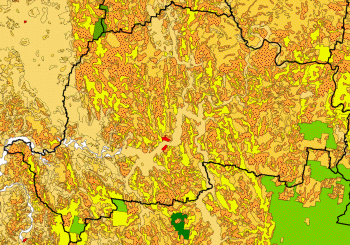
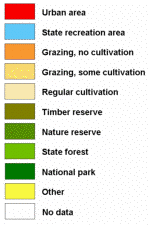
Source: NSW Department of Lands 2008
Some 53% of land within the Shire is classed as suitable for grazing of which 84% of this land is used for this purpose. The remaining land is considered at high risk of erosion if cleared and it is recommended that it be revegetated (DWE).
Around 15% of the Shire is under cropping, of which 98% is incompatible for its location for reasons of either climatic conditions or future soil degradation (CSIRO 2003).
17% of the Shire is mixed farming with 44% of this unsuitable for the location. (Gundagai Shire Council - State of Environment Report 2004).
Table 1: Area (ha) of landuse types within each land capability class in Gundagai Shire
| Landuse | Land Capability Class | |||||||
|---|---|---|---|---|---|---|---|---|
| Lands suitable for regular cultivation | Lands suitable for grazing—occasional cultivation | Lands suitable for grazing—no cultivation | Other lands | |||||
| I | II | III | IV | V | VI | VII | VIII | |
| Cropping | 389 | 5,321 | 4,811 | 5,482 | 4,308 | 10,548 | 5,365 | 45 |
| Estimated grazing | 1,314 | 12,507 | 5,914 | 30,289 | 13,190 | 44,952 | 20,458 | 598 |
| Mixed farming | 543 | 5,794 | 2,523 | 8,921 | 5,289 | 11,946 | 5,886 | 1 |
| Other plantations | 0.1 | 7 | 399 | 2,073 | 215 | 1,578 | 235 | 32 |
| Totals (hectares) | 2,245 | 23,629 | 13,647 | 46,766 | 23,002 | 69,025 | 31,944 | 677 |
Types of land degradation
Erosion
Soil erosion data was restricted to surveys carried out between 1985 and 1992 (refer Figure 2 and Tables 2 and 3). The surveys revealed 525km of gully erosion and 160km streambank erosion (refer Table 2). Minor to severe sheet erosion was present throughout the Shire (refer Table 3).
Over 50% of gully erosion was classed as sever to extreme with most gullies less than 3m deep (Table 2), most of which was caused soon after the original vegetation was removed. Gully lengths have since stabilised, however accelerated erosion continues as is revealed by the high sediment loads to streams relative to (Hughes and Prosser 2003). In New South Wales (NSW), the estimated overall accelerated erosion rate are 10–50 times the natural rates (Edwards and Zierholz 2001).
Figure 2: Degree of erosion within the Gundagai Shire
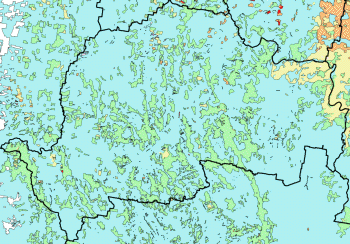
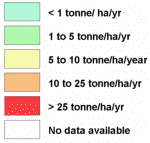
Source: NSW Department of Lands 2008
| Erosion type | Depth | Kilometres |
|---|---|---|
| Extreme gully erosion | greater than 6m deep | 13 |
| 3 to 6m deep | 19 | |
| 1.5 to 3m deep | 85 | |
| less than 1.5m deep | 49 | |
| Extreme gully erosion total | 166 | |
| Severe gully erosion | 3 to 6m deep | 3 |
| 1.5 to 3m deep | 52 | |
| less than 1.5m deep | 59 | |
| Severe gully erosion total | 114 | |
| Moderate gully erosion | 1.5 to 3m deep | 13 |
| less than 1.5m deep | 153 | |
| Moderate gully erosion total | 166 | |
| Minor gully erosion | 1.5 to 3m deep | 28 |
| less than 1.5m deep | 51 | |
| Minor gully erosion total | 79 | |
| Streambank erosion | 3 to 6m deep | 17 |
| 1.5 to 3m deep | 82 | |
| less than 1.5m deep | 58 | |
| Streambank erosion total | 157 |
| Major erosion type | Degree / type | Hectares |
|---|---|---|
| Mass movement | slide | 1 |
| slump | 19 | |
| soil debris avalanche | 20 | |
| Rill erosion | extreme rill erosion | 67 |
| severe rill erosion | 114 | |
| moderate rill erosion | 532 | |
| minor rill erosion | 1,013 | |
| Sheet erosion | severe sheet erosion | 545 |
| moderate sheet erosion | 8,466 | |
| minor sheet erosion | 58,667 |
Salinity
Currently, there is no soil salinity affected areas within the Gundagai Shire . However, forecast have salinity hazards covering approximately 30% of the Shire have been identified up to the year 2050 (refer Figure 3 and 4). Should no preventative action be undertaken isolated areas to the north, south-west, south and centre as well as a large area covering most of the south-east and extending into Tumut Shire (total area ~300km2).
Figure 3: Extent of salinity (2000)
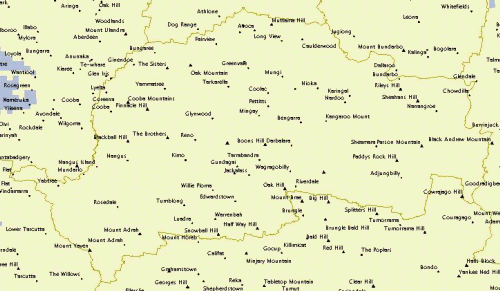
Source: Australian National Resource Atlas 2001
Figure 4: Forecast extent of salinity (2050)
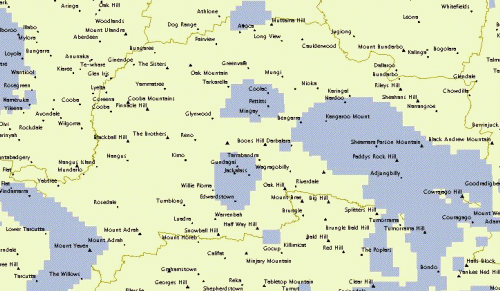
Source: Australian National Resource Atlas 2001
Acid soils
Soil acidity can have an impact reducing crop yields, perennial pastures, ground water quality and inturn increase soil erosion and salinity (Upjohn et al., 2005). In rural Australia soil acidity is usually associated with nutrient depletion or fertiliser use by agriculture. In Gundagai Shire, soil classed as strongly acid covered approximately 34% of the district.
Causes of land degradation
Land degradation can be caused directly by human activities, such as land clearing, over use of fertiliser and changing water tables. Indirect influences, can include flooding of overgrazed or over cultivated land with little ground cover and erosion by wind and water. Drought breaking rain may also cause erosion and can make up about 90% of the total soil loss in an area in a 20–30 year cycle (DPI 2005).
Drought and vegetation condition
According to a recent study by the Bureau of Meteorology (BoM) and Commonwealth Scientific and Industrial Research Organisation (CSIRO) (BoM, CSIRO 2008) the frequency and extent of exceptionally hot years and exceptionally dry years in NSW are likely to increase in the future. The mean projections indicate that:
- by 2010-2040, exceptionally hot years are likely to affect about 60% of the region, and occur every 1.6 years on average;
- by 2010-2040, no change is likely in the frequency or areal extent of exceptionally low rainfall years;
- by 2030, exceptionally low soil moisture years are likely to affect about 7% of the region and occur about once every 14 years on average.
As of September 2008 the Department of Primary Industry has classed 71.6% of NSW as ‘In drought’. This includes most of Gundagai Shire (refer.Figure 5)
Figure 5. Drought declared areas (as of September 2008)
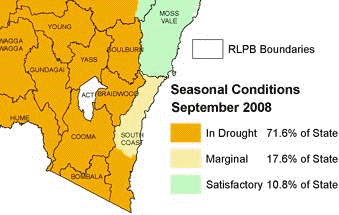
Source:NSW Department of Primary Industries 2008
Gundagai Rural Land Protection Board rated the Gundagai Shire to be in drought for much of the reporting period and continuing past the reporting period (refer Table 4)(DPI 2008). Figure 6. illustrates the impact of the drought on pasture growth for the area (NAMS 2008). Pasture growth reached 0% for much of 2007 but made a steady recovery despite drought conditions remaining.
| Months | Seasonal Conditions |
|---|---|
| September 2004 | Drought |
| December 2004 | Satisfactory |
| March 2005 | Satisfactory |
| June 2005 | Drought |
| September 2005 | Marginal |
| December 2005 | Satisfactory |
| March 2006 | Satisfactory |
| June 2006 | Drought |
| September 2006 | Drought |
| December 2006 | Drought |
| March 2007 | Drought |
| June 2007 | Drought |
| September 2007 | Drought |
| December 2007 | Drought |
| March 2008 | Drought |
| June 2008 | Drought |
Figure 6: Pasture growth in the Gundagai for the period 2004 to 2008
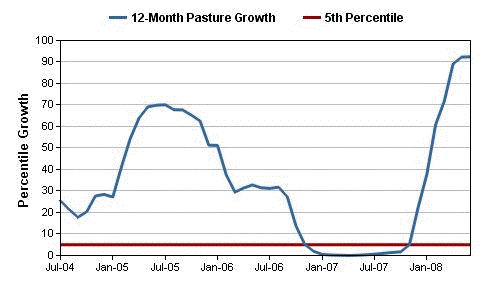
What is being done to improve land condition?
Gundagai Shire Council is located within the Murrumbidgee Catchment Management Authority (CMA). The Murrumbidgee CMA is responsible for planning natural resource and catchment management actions and projects in the Murrumbidgee Catchment. However, as Queanbeyan is a key stakeholder in the majority of the management actions identified by the CMA, it also has a key role in natural resource and catchment management in the local community.
Gundagai Shire Council also supports a number of landcare groups to undertake on-ground works to help reduce many land issues such as erosion. Support is provided to these groups in conjunction with the Murrumbidgee CMA
About the data
For the current reporting period there has been a lack of new soil data due to the relatively long intervals between studies. Given the relevancy of the information in the 2000-2004 report, some sections have been retained for this report. Where material has been used from the Supplementary Report reference has been given to the report and original source.
References
Australian National Resource Atlas Mapmaker facility http://www.anra.gov.au/mapmaker/mapservlet?app=anra
Australian Water Resources (2000) National Land and Water Audit. www.nlwra.gov.au/
Australian Water Resources (2005) Land Salinity Maps. www.nlwra.gov.au/
BoM and CSIRO – see Bureau of Meteorology and Commonwealth Scientific and Industrial Research Organisation
BoM and CSIRO (2008) An Assessment of the Impact of Climate Change on the Nature and Frequency of Exceptional Climatic Event.
Commonwealth of Australia (2005) National Action Plan for Salinity and Water Quality and Natural Heritage Trust Regional Programs Report 2003–04, Departments of the Environment and Heritage and Agriculture, Fisheries and Forestry, viewed 18 April 2005, http://www.nrm.gov.au/publications/regional-report/03-04/.
CRCCH—see Cooperative Research Centre for Catchment Hydrology
Department of Infrastructure, Planning and Natural Resources, NSW (2004a) 2003/04 Combined NSW Catchment Management Authorities Annual Report, Volume 1: CMA Activities and Achievements, Department of Infrastructure, Planning and Natural Resources, Sydney.
Department of Infrastructure, Planning and Natural Resources, NSW (2005) Meeting the Challenge: NSW Salinity Strategy Premier's Annual Report 2003–04. NSW Department of Infrastructure, Planning and Natural Resources, viewed 12 May 2006, http://www.dlwc.nsw.gov.au/salinity/pdf/2003_2004_salinity_annual_report.pdf
Department of Land and Water Conservation (NSW) (1999) Groundwater Quality Protection Policy, Department of land and Water Conservation, Sydney, on line at http://www.dnr.nsw.gov.au/water/pdf/nsw_state_groundwater_quality_policy.pdf.
Department of Land and Water Conservation, NSW (2000) Taking on the Challenge: The NSW Salinity Strategy, Department of Infrastructure, Planning and Natural Resources, viewed 4 May 2006, http://www.dlwc.nsw.gov.au/salinity/government/govt-docs.htm.
Department of Land and Water Conservation, NSW (2002) Soil Acidification Hazard Mapping , produced for the 2003 NSW State of the Environment Report, Department of Land and Water Conservation, Parramatta.
Department of Lands NSW (2008) Soil Landscape Mapping Program – Soil and Landscape Qualities and Limitations http://www.naturalresources.nsw.gov.au/care/soil/ssu/quals4.htm
Department of Primary Industries, NSW (2005) Soil Management Following Drought, Agnote DPI 355, Third Edition, Department of Primary Industries, viewed 18 April 2006, http://www.agric.nsw.gov.au/reader/pasture-crops-recovery/dpi355.htm.
Department of Primary Industries, NSW (2006) Drought maps—areas of NSW suffering drought conditions, Department of Primary Industries, viewed 8 May 2006, http://www.agric.nsw.gov.au/reader/drt-area?picQuant=100.
Department of Primary Industries, NSW (2008) Drought maps and drought assistance eligibility status of RLPBs http://www.dpi.nsw.gov.au/agriculture/emergency/drought/situation/drought-maps
DIPNR—see Department of Infrastructure, Planning and Natural Resources, NSW
DLWC—see Department of Land and Water Conservation, NSW
DPI—see Department of Primary Industries, NSW
Edwards, K and Zierholz, C (2001) Soil Formation and Erosion Rates, in PEV Charman and BW Murphy (eds) Soils: Their Properties and Management, 2nd Edition, pp 39–58, Oxford University Press, Oxford, cited in Lu, H, Prosser, IP, Monn, CJ, Gallant, JC, Priestley, G and Stevenson, JG (2003) Predicting sheetwash and rill erosion over the Australian continent, Australian Journal of Soil Research Vol. 41, 1037–1062, viewed 3 May 2006, http://palaeoworks.anu.edu.au/pubs/AustJSS03.pdf.
Hughes, AO and Prosser, IP (2003) Gully and Riverbank Erosion Mapping for the Murray-Darling Basin, Technical Report 3/03, March 2003, CSIRO Land and Water, Canberra, viewed 26 April 2006, http://www.clw.csiro.au/publications/technical2003/tr3-03.pdf.
Upjohn, B., Fenton, G. and Conyers, M. (2005) Soil Acidity and Liming Agfact AC.19 3rd Edition. NSW Department of Primary Industries, viewed 17 July 2006, http://www.agric.nsw.gov.au/reader/soil-acid/2991-soil-acidity-and-liming-.pdf
